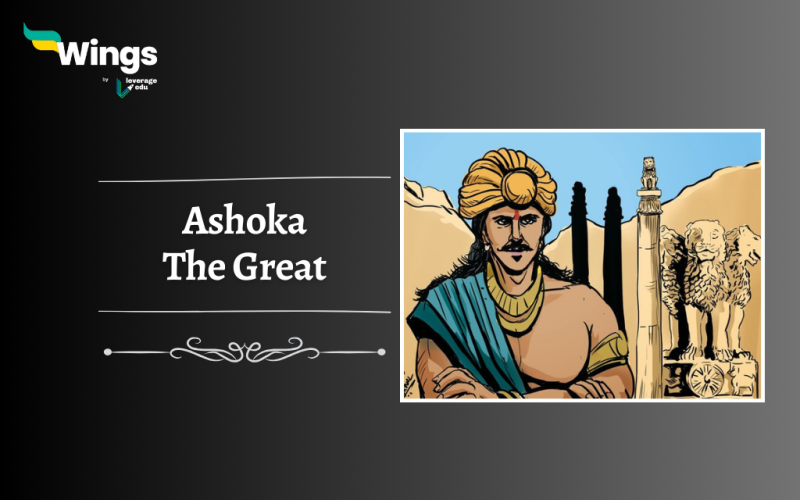We always hear the name Ashoka and our mind translates it as; Ashoka the Great. This third ruler of the Mauryan empire has undergone a great ideological transformation. On the path to becoming the greatest conqueror, Ashoka discovered a way to become the greatest preacher of life and non-violence.
He was born in 268 BCE as the second of the four sons of Bindusara. His death date is recorded to be 232 BCE. During these years of his life, Ashoka had earned a great name for himself. Ashoka was not destined to rule being the second child but he was well trained in the proceedings of the court, equipped with the knowledge of martial arts, and also gained expertise in Arthashastra.
Table of Contents [show]
What is Ashoka Famous For?
Ashoka is known for his bloodlust and for the fact that he conquered a landmass stretching from modern-day Iran to the subcontinent of India. Ashoka is to Indians what Alexander is to the West. He conquered the largest landmass any Indian king had ever done. He is also famous for propagating the path of non-violence as the king turned saint accepted and abided by the path of Buddhism.

Also Read: Babur: The Magnificent History of the First Mughal Emperor
How Did Ashoka Came to Power?
Ashoka was a competent warrior as well as a courtier. His tactics impressed everyone except for his father who particularly disliked him. Anyhow, the prince raised in Patliputra was sent to Takshashila to curb a mutiny. He was greeted by the locals in peace and no violence was required to put down the revolt.

He was then sent to govern Ujjain, the commercial capital of the city and the town thrived under the young ruler. When the revolt in Takshashila broke out again, Bindusara sent his elder son, Susima, the assumed heir to the throne; to handle the upsurge of rebellion.
During this, the king had fallen sick and Ashoka assumed the throne as he died. After this, he killed all his brothers to ensure no one claimed the throne. His rule during this time is known to be brutal and torturous. His prison came to be known as ‘Ashoka’s hell’.
Administration of Ashoka
Ashoka, the Great ruled from 268 BCE to 232 BCE i.e. the entire subcontinent of India, except some parts of Tamil Nadu and Kerala.
- His capital was Pataliputra, present-day Patna.
- He also built two provincial capitals under his administration named – Ujjain and Takshashila later known as Taxila.
- During the rule of his father Bindusara, Ashoka was serving as the viceroy of Ujjain.
| Ashoka Biography Overview | |
| Birth | 304 BCE |
| Birthplace | Pataliputra, Present day- Patna |
| Rule | 268 BCE to 232 BCE |
| Educations | Skilled in statecraft, philosophy, warfare and economics. |
| Works | The propagation of Dhamma spread Buddhism across South Asia and the European subcontinent. |
| Legacy | Known as one of the greatest emperors in Indian history because of his just and moral administration |
| Death | 232 BCE |
Also Read: Samudragupta Maurya– The Indian Napolean
The Battle of Kalinga

Ashoka had a great ambition of conquering beyond the boundaries of the Mauryan empire. Due to some reasons, he invaded the kingdom of Kalinga during this time. He killed 100,000 inhabitants there and deported 150,000 more. The rest were left to die of disease and famine. After the was over he walked over the battlefield looking at thousands of carcasses, unidentifiable bodies of soldiers and the destruction. The stony silence of the picture of death he had immortalised on the battlefield of Kalinga made him hear his own breath. It brought about a change of heart in Ashoka, who then drifted towards the teachings of Buddhism.
Ashoka: Beliefs & Life Lessons

Ashoka renunciate war and established the path of Dhamma a pious way of living for the people. He propagated Dhamma and Buddhism all across India. He also became a great propagator of Arthshastra. The great Ashoka pillars are evidence of his barbarity. The pillars address the incidents of the battle of Kalinga and were also his way of lamenting the dead and honouring their sacrifice.
Relevant Blogs
That is all about Ashoka the Great! If you want to know more about topics like this, then visit our general knowledge page! Alternatively, you can also read our blog on general knowledge for competitive exams!
 One app for all your study abroad needs
One app for all your study abroad needs















 45,000+ students trusted us with their dreams. Take the first step today!
45,000+ students trusted us with their dreams. Take the first step today!
